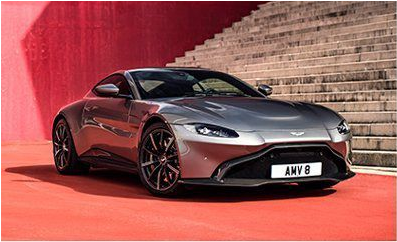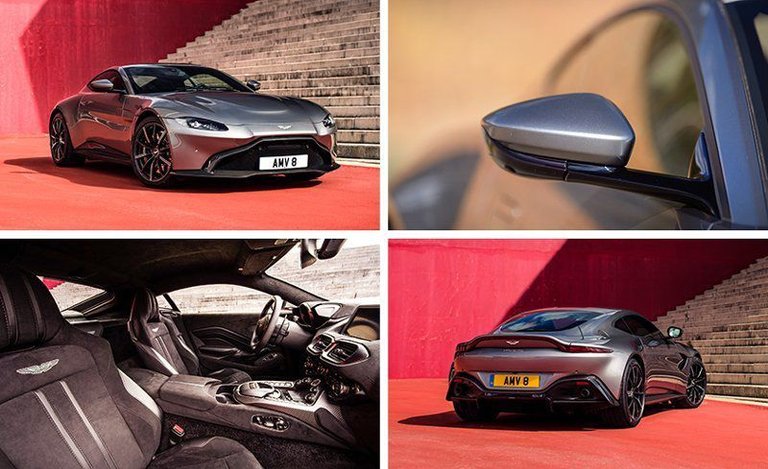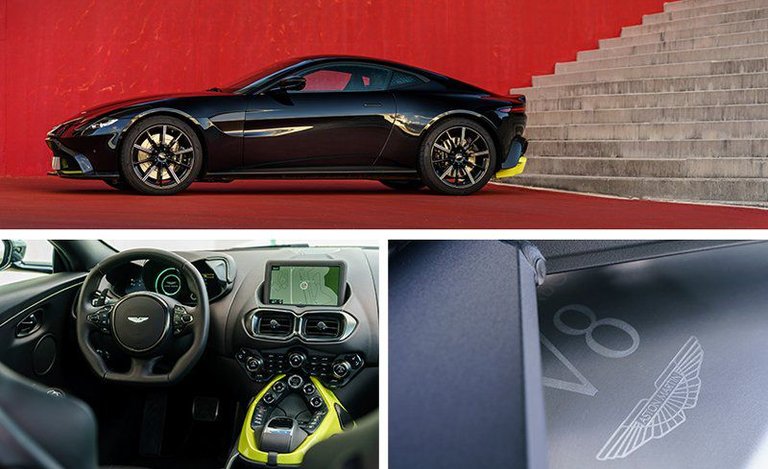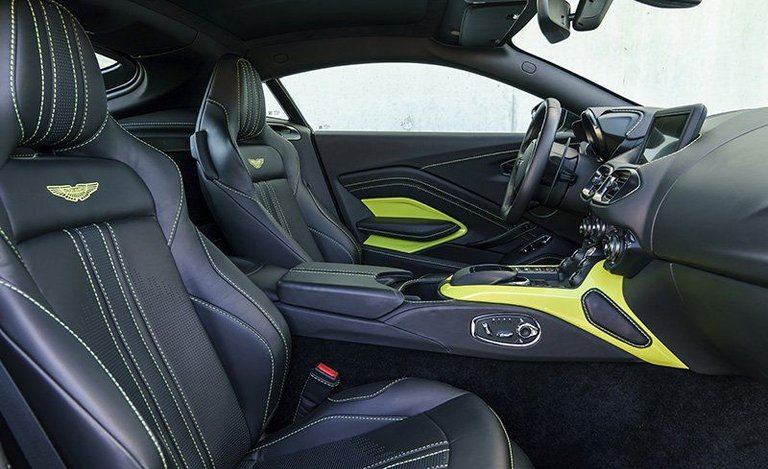Even with a German heart, the Vantage remains a quintessential British sports car.

Portugal’s Algarve International Circuit is a thriller, a lumpy 2.9-mile squiggle that marries the apexes of its 14 corners to the crests of the Faro region’s hills in both playful and malevolent ways. It’s particularly exciting in the wet, even more so with a twin-turbo V-8 abusing a pair of Pirelli P Zeros with 505 lb-ft of torque.
Aston Martin Vantage senior vehicle engineering manager Craig Jamieson is hardly worried about a little precipitation. It is a British sports car, after all. “If you’re not having fun,” Jamieson says, “please come talk to me.

Must. Catch. Own. Tail
Rain or not, we’re having fun. Regardless of the conditions, the new Vantage just wants to play, like a four-wheeled Labrador puppy. It’s hugely responsive to load swings, a rear-driver that reacts faithfully to driver inputs and rotates readily yet predictably. The standard electronically controlled limited-slip differential invites us to prod the throttle earlier and earlier on corner exit. The steering clearly communicates when the 255/40ZR-20 front Pirellis are slipping into understeer, and with a 13.1:1 ratio, the rack is quick without being twitchy. The steering is not so heavy that you need a squared wheel with corners to purchase against, but the extra effort does make it easy for fast-moving hands to stay oriented as you feel your way around the wheel. Lap after lap, the optional carbon-ceramic brake rotors turn the front straight’s 150-plus mph into 40-mph hairpins without a hint of fade, the pedal offering little travel, instead responding to pressure the way the best cars’ do. The carbon-ceramics save about 43 pounds, although the constant spray probably means the standard iron discs would dissipate heat with particular efficiency today, too.
This circuit in these conditions could be unnerving, but the Vantage yearns to be driven no matter what. It is best to leave stability control on, though. The Mercedes-AMG–sourced twin-turbocharged 4.0-liter V-8’s prodigious torque means that in low-traction situations, the Vantage approaches the limit the way an overcaffeinated lemming does cliffs: Whee! A Track setting in the stability-control programming allows more yaw before interceding, but in the rain, it’s hard to feel out that window before arriving at the threshold.

While some aspects of Aston’s long-serving VH architecture live on, the new Vantage’s bonded-aluminum structure relies more heavily on stamped panels, rather than the blocky extrusions that formed the old VH. This construction is not only more space efficient than before, it’s stiffer, too. Jamieson tells us the 2019 Vantage is 30 percent more rigid than its predecessor yet more than 40 pounds lighter. A few stampings and castings in the central structure are shared with the DB11, but Aston says 70 percent of the structure is unique to the Vantage. There are forged-aluminum control arms up front, with cast-aluminum bits in the multilink rear. Non-isolated rear-subframe mounts deserve much of the credit for the handling fidelity.
The morning after our track outing brings more rain—enough that some of the pavement on our drive route is washed out or strewn with small rock slides. Aston has rather self-consciously labeled the base setting for the adaptive dampers and other parameters Sport. When even a Lamborghini Huracán starts in Strada (street), that comes off as a little contrived. The mid-level setting is Sport Plus, with Track at the top. Track flirts with discomfort but remains supple enough for short drives.
German Guts
But with the day’s highly compromised visibility, we’re not pushing the car hard enough to benefit from the tighter body control anyway. A cloud bank has settled about halfway up the Serra de Monchique mountain range, the road climbing and descending in and out of it. Given a clear view, no passing zone is too short, thanks to the 503-hp AMG V-8. The money Aston saved by purchasing an engine from another automaker rather than developing its own is surely part of the reason the rest of the Vantage is so good, but there’s another interesting byproduct of this outsourcing: Aston engineers and executives can fawn over this engine more than would sound sincere were they talking about something they’d developed themselves. When someone says of their own creation that it’s the “best in the world,” it sounds suspiciously conceited. But saying that of AMG’s engine allows Aston’s people to pat someone else on the back while also taking credit for their own excellent taste.
The mill is as impressive here as it is anywhere, with gobs of torque providing a burly immediacy. The Vantage should hit 60 mph from a standstill in just 3.4 seconds and charge all the way up to 195 mph before losing out to aerodynamic drag. Aston spent significant time and energy tuning the intake and exhaust systems to dull the lower frequencies and enhance the higher ones. A resonator tube plumbs intake noise from the manifold into the cabin. But engineering manager Jamieson is quick to point out that there is nothing synthetic playing through the speakers; this is all natural sound. Under load and in the last third of the tach, the Vantage has the high-pitched shriek of its naturally aspirated V-8 predecessor; but at startup, the growl is all AMG, the low rumble of a distant avalanche.
Behind the German V-8 is a German eight-speed automatic. The paddle-shifted ZF unit mounts at the back of the car, spun by a carbon-fiber driveshaft twirling inside an aluminum torque tube. While the torque-converter automatic’s shifts are imperceptibly slower than the best dual-clutch transmissions’, the smooth torque delivery and flawless low-speed behavior suit this car just fine.
Smell the Rainbow
Aston representatives make no secret of their plan to soon offer a manual transmission in the Vantage. Indeed, one of the benefits of the rear-mounted transaxle is that it will make a natural shifter location easier. In the previous-generation Vantage, the car’s high tunnel made for an awkward placement. The new car’s engineers cite the Porsche 718 Cayman—a car that feels as natural as a birthday suit—as their ergonomic benchmark. But if there’s anything else awkward about the interior, blame the person who spec’d it. There are 41 colors in the exterior palette, 16 choices for the main interior (offering 35 colors for stitching, 13 for headliners and carpets, and six for seatbelts), and five finishes for the door and center-console trim. Aside from the radio and HVAC buttons, which look a little cheap for a $150,000 car, all the materials are top notch. Aston chief creative officer and lead designer Marek Reichman says: “The aluminum is real aluminum. The glass buttons are glass buttons, the leather is the finest quality leather from Bridge of Weir.”

In addition to the engine, Aston also sources its infotainment system from Mercedes, where it is called COMAND. It’s hard to say which was the smarter move. The industry-wide rush to incorporate Android Auto and Apple CarPlay is evidence of the fast-evolving complexity of these systems, and for an automaker of Aston Martin’s size, getting it right could easily consume an inordinate amount of the development budget. Aston preserves COMAND’s intuitive menu structure and control knob, tweaking only the fonts. Unfortunately, its choice of typeface makes the system look old.
Like Some Kind of Fancy Suit Worn by Some Fancy Guy
Nothing else about the Vantage does, though. The oversize take on Aston’s traditional grille, the predatory slant and squint of the headlights, the daring taper of the greenhouse, the bulge in the fenders—“the wheels pushing themselves out of the bodywork, like they’re forcing themselves from the skin,” as Reichman puts it—it’s all thoroughly modern. The Vantage manages to maintain the unmistakable proportions of an Aston Martin and still look like nothing the company has ever produced before. Aside from the James Bond–only DB10, of course. It always looks desperate when studios cast a concept car in a movie, but turning that progression on its head and using a movie to introduce a car that looks like a concept and then rolling out a production Vantage that looks just like the movie car—well, that was a smart move.
Vantage deliveries begin in July. By concept-car standards, its $153,081 base price is a steal. As for other real-world vehicles, that lands right in between the Mercedes-AMG GT C and GT R, with which the Aston shares its 4.0-liter V-8, and close to the Porsche 911 Turbo. The 911’s shape is as familiar as that dread you feel betting on a Michigan sports team, and not even the GT R in its satin Green Hell Magno paint can turn heads the way the Vantage can. But the Vantage has a lot more than just its looks to recommend it. And you don’t need to worry about driving it in the rain.
@dheerajjin, welcome and congratulations on making your first post! I gave you a $.02 vote! If you would be so kind to give me a follow in return that would be awesome!
Hi! I am a robot. I just upvoted you! I found similar content that readers might be interested in:
http://us.pressfrom.com/autos/reviews/-135140-2019-aston-martin-vantage/
Nice
thankas
Congratulations @dheerajjin! You received a personal award!
You can view your badges on your Steem Board and compare to others on the Steem Ranking
Vote for @Steemitboard as a witness to get one more award and increased upvotes!